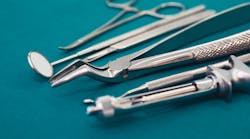In 2013 an Oklahoma dental clinic exposed thousands of patients to HIV and hepatitis due to improper sterilization practices.1 Upon investigation, it was found that one of the many breaches was the improper use, or lack of use, of the autoclave. The clinic had never conducted tests on its autoclave to examine if it was sterilizing correctly in six years. Six years!
Do you know of any dental office without an autoclave? Neither do I. They are crucial for safeguarding against failure on any biological, health, and safety procedures. Proper checks and maintenance are critical as there are many reasons why an autoclave might run an improper sterilization cycle (e.g., human error, component failure, and insufficient steam). Not all autoclaves are created equal; it's best to go with a gold-standard machine that is simple to operate, test, and maintain.
Typical office autoclaves
Time, pressure, and temperature will vary according to the type of autoclave an office chooses.2 Steam autoclaves are most commonly found in dental offices, and as medical devices, they require clearance by the FDA before they are allowed on the market. Gravity sterilizers are the primary type used, and they use chamber pressurization, steam, and high temperatures to kill almost all of the bugs.
You might also be interested in: 4 infection control missteps to avoid
A cleaning cycle lasts approximately 15-30 minutes, not including the preparation time, taking a shorter amount of time if the temperature is higher. Postcycle, the machine will need to depressurize and dry, which can take an additional 20-45 mins. Remember, the drying cycle is included in the sterilization of instruments. This means, leaving the instruments in the autoclave to complete the dry cycle is necessary to say the instruments went through an entire sterilization cycle.
Prevacuum autoclaves, also known as class B autoclaves, use slightly different technology and are considerably faster, taking around 45 minutes for a complete cycle. Considering how quickly most offices must turn around patients, faster sterilization time means this type is becoming increasingly popular.
Newer models
When upgrading to a class B autoclave, there are a few things to consider.3 The first is capacity. While the larger capacity models are more expensive to buy and run when sterilizing larger loads, it is better to use this than overloading a smaller model, which can result in sterilization failure. Still, having a machine that’s bigger than you need is expensive, so consider investing in two smaller-sized models and running them simultaneously when there is a heavy load. Another thing to take into account is the length of the sterilization cycle. Faster models are usually more expensive but recommended for a fast-paced practice with a high turnaround of patients. Finally, contemplate warranties and servicing and ensure the company has a decent warranty length with support and technical service readily available.
My recommendation
The best autoclave for you depends on your practice. If your office struggles with team members removing the items before the dry cycle is complete or with packages coming out wet, you may consider a type B autoclave. If your office is a bit old school, there are some great manual autoclaves on the market. They are virtually maintenance-free and quiet and do not compromise on safety or quality. There is also a closed-door drying mode to help with those team members who are eager to unload before the completed dry cycle.
However, even gold-standard autoclaves are only as good as their handler. Testing and biological indicators are imperative after each sterilization cycle to ensure that things are working correctly. It’s also necessary to be relentless about policy, procedures, and training for use. When it comes to autoclaves, I love them quick, but please, not dirty!
Editor's note: This article appeared in the May 2023 print edition of RDH magazine. Dental hygienists in North America are eligible for a complimentary print subscription. Sign up here.
References
1. Elsenpeter R. The WORST infection control breach stories. Dental Products Report. Published December 6, 2018. Accessed December 30, 2022. https://www.dentalproductsreport.com/view/worst-infection-control-breach-stories
2. Cuny E, Bednarsh H. Instrument sterilization in dentistry. RDH magazine. Published March 31, 2007. Accessed December 30, 2022. https://www.rdhmag.com/infection-control/sterilization/article/16407115/instrument-sterilization-in-dentistry
3. Class B autoclaves: How to choose the best for your dental practice? Published April 8, 2022. Accessed December 30, 2022. https://www.dentaltix.com/en/blog/class-b-autoclaves-how-choose-best-your-dental-practice







